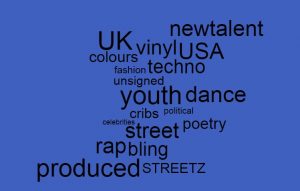LESSON 1
Task 1 – What genre?
Pick a Genre – probably best to choose a genre of music you understand, like and can be excited about. That said, some genres of music have very specific conventions and might be able to provide you with much more scope for design decisions and copy style. If you are undecided perhaps choose a very obvious genre i.e. punk, heavy metal?
Research various genres – you will be amazed how many sub-genres and sub-cultures there are. These are just a few.

Task 2 – Choose the name of the magazine.
Use a generator app or a thesaurus for a simple, catchy and relevant name of the magazine. It has to be catchy and relate to your genre and brand – make it relevant to your target audience.
- Bonus, Fault, Exchange, Storm, Louder, Open Mic, Score, Epoch, Placebo, Audio, Stream, Hustle, Phonic, Whisper, N&U (new and unsigned), Orbit, Swipe, Double Tap, Like, Status, Plectrum.
Task 3 – Brand Wordcloud/Mission Statement – Blog Post
Create a wordcloud that includes all the words that relate to what might be your mission statement for your magazine. For example will you magazine feature: new talent, unsigned artists, fashion, concerts, festivals, be edgy, anarchic, energetic? Address all 4 of the Uses and Gratification that Blumler and Katz talk about to ensure maximising your sales to ensure that your contents will appeal to their use of the text. Include the name of the magazine in a different colour.
This is an example wordle for a HipHop/Rap magazine called STREETZ.

Blog post – introduce your magazine and its name. Outline the genre and then create a couple of lines for its mission statement which will also be part of the wordle on the magazine’s brand.
This is a link to a perfect mission statement – the second half is the one you should go for!
LESSON 2
Task 4 – Facebook profile
Now that you have an idea of what your audience is all about, you need to know more about the audience. Using yougov.uk and your imagination, create a facebook profile of your target audience. Keep them in mind all the time when you are designing to ensure you are hitting the target, satisfying their needs and giving them predictable pleasure.
You may have to think laterally to find a similar audience member to search for their profile in yougov.co.uk.
- Make a copy of this Facebook profile and complete it for your target audience. Use your research to inform your status, details, favourites, interests etc and also use your imagination.



